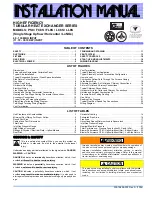
Personal Ambulatory Oxygen System
Provider Technical Manual
20771733 D 17
Assembly and Alarm Verification Tests
To ensure proper assembly and functionality of the eQuinox after it has
been reassembled, the following steps should be followed.
1. Install the Battery Pack into the Battery Pack compartment of
the eQuinox. Plug the AC Power Supply into the wall outlet and
connect it to the External Power Connector of the eQuinox.
2. Press the ON button and set the eQuinox to 2 LPM. At initial
start-up, the eQuinox will light the Green, Yellow and Red LED’s
accompanied by a beep. As concentration increases to ~70%,
the Red LED turns off and the Yellow and Green remain on. When
the concentration reaches normal operating range (above 85%),
the Yellow LED will turn off. The Green LED will stay lit indicating
normal operation. Table 3 shows the normal start-up operating
conditions for eQuinox Oxygen Systems. If LED is not green within
7 minutes there may be a problem with the eQuinox.
Green
Indicator
Yellow
Indicator
Red
Indicator
Audible
Alarm
Alarm
code
Operating
Condition
Off
Off
Blinking
Beeps
0004
Purity < 70%
Off
Blinking
Off
Off
0008
Purity
between 70%
and 85%
On
Off
Off
Off
0000
Normal
Operating
Condition
Table 6
3. Verify that the Battery Pack is charging as indicated by the Battery
Pack Status Gauge is moving in waterfall fashion (scrolling from
bottom to top). If the Battery Pack Status Gauge is not moving,
verify that the Battery Pack is properly engaged.
4. Check the Control Panel by pressing each of the Increase/
Decrease, Pulse Dose Mode and No Smoking buttons and
observe that the eQuinox buttons function normally.
5. Press the Delivery Mode button and set the eQuinox to the
patient’s normal Pulse Dose setting. Confirm that without
breathing from the unit, after 15 seconds of no breath detected,
the system changes automatically to Continuous Flow Mode. The
green Delivery Mode light is blinking fast, indicating the system
is delivering a Continuous Flow. After another 15 seconds, the
system stops delivering Continuous Flow and waits 15 seconds
trying to detect a breath. The cycle continues until a breath is
detected.
6. After 5 minutes of operation, block the Cannula Fitting Outlet with
your finger for 2 minutes and confirm that the visual and audible
alarm occurs. Unblock the Cannula Outlet Port and let it stabilize
until the alarm stops.
7. Disconnect the AC Power Supply and allow the eQuinox to run
for about one minute. Set the eQuinox to the patient’s normal
Continuous Mode setting. Confirm that the Battery Pack Status
Gauge is illuminated and External Power Present Indicator is off.
8. Remove the Battery Pack and verify that the eQuinox alarms and
red Alarm Indicator is flashing and the alarm sounds. After about
5 seconds, re-install the Battery Pack and connect the AC Adapter
and observe that the eQuinox automatically restarts. Confirm that
the External Power Present Indicator is illuminated.
9. Turn off eQuinox and unplug the AC Power Supply.
10. Record results, initial and date the Service and Maintenance
Record.
11. EDAT may be utilized to record eQuinox device status and dates
of service.
Electrical Safety Test
This is required only for the eQuinox Oxygen System, that is used in a
hospital or institutional environment. This is not required for home care
use.
To test the basic electrical safety of the eQuinox AC Power Supply,
CAIRE recommends using an LKG-601 Electrical Safety Analyzer
(Netech Corporation, Hicksville, NY) or equivalent to verify that the
current leakage to ground is within appropriate limits.
1. Plug the AC Power Supply into the electrical safety analyzer.
Disconnect the AC Power Supply from the eQuinox unit.
2. Plug the electrical safety analyzer into a wall outlet.
3. Follow the analyzer manufacturer’s instructions for measuring
both the forward and reverse earth leakage current only. Verify
that forward and reverse-current leakage to ground is < 250
µA (100/115VAC applications) and < 500 µA (220/240VAC
applications).
4. Disconnect the AC Power Supply from the electrical safety
analyzer.
5. If the AC Power Supply measures leakage current greater than the
criteria in step 3, please return it to CAIRE for service.
6. EDAT may be utilized to record eQuinox device status and dates
of service.
Cleaning the eQuinox
Clean inside the unit, as needed, using a small vacuum cleaner or
brush to remove any accumulation of dust or debris prior to attaching
the covers. After reinstalling the cover, verify that the rubber gasket is
installed correctly.
Use mild detergent solution to clean the cabinet, Control Panel and
power supplies. Turn OFF the eQuinox and discon nect from AC or DC
power before any cleaning or disinfection activity. DO NOT spray the
cabinet Control Panel or power supplies. Use a damp (not soaking
wet) cloth or sponge. Spray the cloth or sponge with a mild detergent
solution to clean the cabinet and power supplies. To disinfect the
eQuinox, use Lysol® Brand II disinfectant. Proceed as directed by the
manufacturer.
WARNING:
Disconnect and Remove ALL power supply
connectors before cleaning the exterior cabinet. DO
NOT use denatured alcohol or apply liquid spray or
aerosol cleaners.
















































